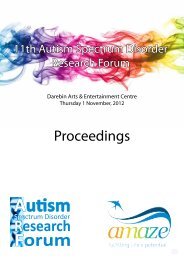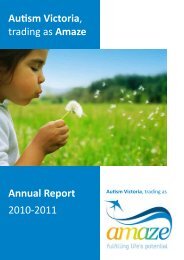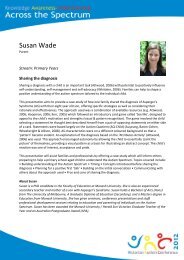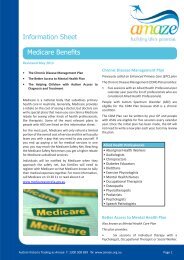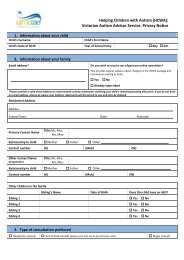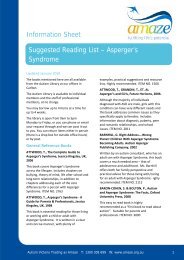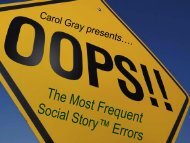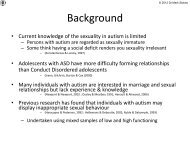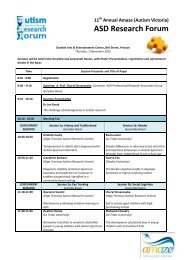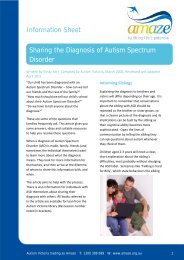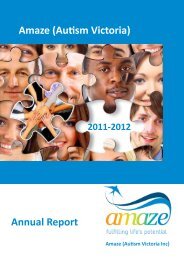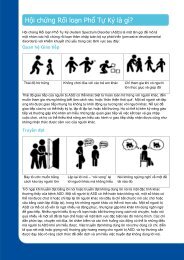Information Sheet Bullying and Autism Spectrum Disorders - Amaze
Information Sheet Bullying and Autism Spectrum Disorders - Amaze
Information Sheet Bullying and Autism Spectrum Disorders - Amaze
- No tags were found...
Create successful ePaper yourself
Turn your PDF publications into a flip-book with our unique Google optimized e-Paper software.
<strong>Information</strong> <strong>Sheet</strong><strong>Bullying</strong> <strong>and</strong> <strong>Autism</strong> <strong>Spectrum</strong> <strong>Disorders</strong>Taken from The <strong>Spectrum</strong>, Vol.2, No. 1, Autumn 2006, pp 4‐6. Reviewed April 2011Community awareness <strong>and</strong> underst<strong>and</strong>ing ofbullying behaviour has improved in recentyears. Nevertheless, students with an <strong>Autism</strong><strong>Spectrum</strong> Disorder (ASD) remain highlyvulnerable to bullying behaviour, <strong>and</strong>parents, teachers, other students <strong>and</strong> thecommunity must be sensitive to theparticular needs of these students.them unhappy, or you may notice injuriessuch as bruises or scratched, torn clothing ormissing items 2 . Alternatively, changes in yourchild’s behaviour may alert you to thepossibility of bullying.Protecting the student with<strong>Autism</strong> <strong>Spectrum</strong> Disorder frombullying behaviour at schoolOccasionally we received calls from parentswho are concerned about their child beingbullied at school. The majority are parents ofchildren with high‐functioning autism orAsperger Syndrome, attending mainstreamschool. British statistics suggest thatstudents with special education needsattending a mainstream setting are threetimes more likely than their age peers to bebullied 1 . How can you tell if your child hasbeen bullied? What characteristics makestudents with <strong>Autism</strong> <strong>Spectrum</strong> Disorder atarget of bullying? What can parents,teacher <strong>and</strong> peers do to prevent bullying <strong>and</strong>keep the student with <strong>Autism</strong> <strong>Spectrum</strong>Disorder happy <strong>and</strong> safe?Identify that your child is beingbulliedYour child may be able to tell you whensomething happened at school that madeA child who is being bullied may havedifficulties with eating, or sleeping whichwere not previously present, havenightmares with the theme of being verballyor physically hurt, or refuse to go to school 3 .There are other reasons for such behaviour,so it is important to do some furtherinvestigation with the child. A direct (butleading) way is to simply ask the child ifanyone has made them sad. Parents maywish to use a less direct (<strong>and</strong> neutral)approach by use of an emotions timelinewith their child. This lists routines of the dayin chronological order. The child is givenpictures of happy, sad <strong>and</strong> angry. The parentstarts at the beginning of the day <strong>and</strong> saysthe name of the activity (for example,recess) <strong>and</strong> the child selects the correct faceto represent the feeling at that time. If the<strong>Autism</strong> Victoria Trading as <strong>Amaze</strong> T: 1300 308 699 W: www.amaze.org.au 1
3. The child’s sensitivity may maketheir reactions to provocation seem comicalto bullies. The child may become teary orangry quite easily after being taunted, <strong>and</strong>so this is an instant pay‐off for the bullytrying to get a reaction. This is particularly sofor those with Asperger Syndrome.Strategy: Develop a bullying shield with thechild. This is a concrete <strong>and</strong> visual way torepresent protective thoughts for the child.The shield can be as simple as a sheet ofpaper, or as complex as whatever model thechild wants to make. An adult helps the childcome up with some statements to counterwhat is being said to them (for example, thebully says ‘you smell’, <strong>and</strong> the child’sstatement could be ‘I smell like flowers’ or ‘Iwash every day so I smell pleasant’). Theagreed to statement is written on the shield.The child is prompted to think of the shieldwhen being bullied – <strong>and</strong> of the bully’sstatements bouncing off the shield. This isnot necessarily so they can say their counterstatement,but more so they can see thatthe taunt is not true, <strong>and</strong> so remain calm.Some children like to visualise putting on araincoat as a barrier to teasing words insteadof using a more abstract ‘shield’.4. The child who has difficulties withgeneralisation may repeat a mistake from aprevious occasion, retriggering the bully’shumiliation of them. Luke Jackson, author ofFreaks, Geeks <strong>and</strong> Asperger Syndrome 5recounts how he would go to the same placeeach day where the bullies were, notmodifying his behaviour from the last timethey had taunted him. When he did seek tochange this pattern, he went to secludedplaces in the school ground, thinking he washiding from the bullies, but really makinghimself vulnerable to attack withoutwitnesses or other people to intervene.Strategy: The school may provide a safeplace inside to go if needed, such as asupervised indoor activity. If this is notpossible, teach the student who plays in theyard where he can play in plain view of otherstudents <strong>and</strong> staff. If incidents occur withinthe line of sight of the duty teachers or thestaffroom, teachers are more likely to see,<strong>and</strong> respond to an incident.5. The child may not recognise theintent behind the bullying behaviour <strong>and</strong>may actually think the bully is being friendly.Carol Gray highlights an example where achild was asked to ‘shake h<strong>and</strong>s’ withanother child, then pushed to the ground<strong>and</strong> hit.Strategy: Teach the child how to recognisesuspicious or unfriendly behaviour. Ingeneral, shaking h<strong>and</strong>s is an adult activity, sochildren should be suspicious of anotherchild offering this. Similarly, a child offeringto be friends if given money is not a realfriend – teach the child that friendship doesnot need to be paid for. You could also teachthe child that a real friend doesn’t ask you todo something that would hurt yourself orsomeone else.6. A child’s literal interpretation oflanguage may set them up for furtherteasing (for example, showing unusualapproaches to join a group, <strong>and</strong> being told‘go away’. The child may then genuinelyquestion ‘go where?’).<strong>Autism</strong> Victoria Trading as <strong>Amaze</strong> T: 1300 308 699 W: www.amaze.org.au 3
Strategy: If a child recounts an incident suchas this, correct their confusion by providing aconcrete example: ‘when a child says ‘goaway’, they really mean ‘go away from me’,<strong>and</strong> you should move to a different areawhere people look more friendly. If you can’tfind friendly students, go to the duty teacher<strong>and</strong> ask for help.Many of the above strategies havesuggested ways to increase the child’sabilities <strong>and</strong> skills. This is not to say that theirdifficulties are to blame for the bullying,rather that even the most caring teachersmay not see the bullying incidents as theyoccur. In that case, the most immediate wayto help the child is to equip them with themeans to prevent some bullying incidents.Of course the best way to stamp out bullyingaltogether is to deter bullies, catch them outif they persist, <strong>and</strong> then provide appropriatepunishment (see more suggestions forteachers below).More strategies to help the childwho is being bulliedFor ParentsKnow the school’s bullying policy, <strong>and</strong>use this information to your advantage.Every school is required to have abullying policy. Visitwww.education.vic.gov.au/healthwellbeing/safety/bullying/policy.htm for moreinformation.Meet with the school to discussincidents, how these were h<strong>and</strong>led, <strong>and</strong>whether this is in accordance with theschool’s policy. If you have a goodrelationship with the class teacher, beginby talking with them. For more seriousmatters, such as physical violenceagainst your child, or ongoing teasing,requesting a meeting in writing throughthe principal is suggested. For such ameeting, making a list of the issues tocover, <strong>and</strong> bringing alongdocumentation of the events over time(see reference to the ‘grievance book’above) can help keep the meeting ontrack. Ask your partner or a friend tocome to the meeting as a supportperson if you feel overwhelmed speakingto the teacher <strong>and</strong> principal by yourself.If a resolution of grievances cannot beachieved to your satisfaction at teacheror principal level, parents can thencontact the Education Department’sDisability <strong>and</strong> Student Welfare Section intheir region OR the Student WellbeingBranch at Head Office.For TeachersLead by example. Show in your attitude<strong>and</strong> actions that bullying behaviour isnot tolerated by you. Address everyincident you witness or hear about.Don’t turn a blind eye, thinking that thestudents involved should just sort thingsout themselves. Although this may workfor other students, the student with<strong>Autism</strong> <strong>Spectrum</strong> Disorder does not havethe social underst<strong>and</strong>ing, or perspectivetakingability to do this. They will neededucation about what went wrong, <strong>and</strong>why. They will also need a clearguideline about what to do next time totry to avoid the same situationreoccurring.Incorporate specific bullying training intothe curriculum, such as informationabout how to recognise bullying. UseCarol Gray’s ‘How to respond to abullying attempt’ 6 to set up teamsamongst classmates who will then watchout for each other in the playground.This method also teaches childrenexactly what to say <strong>and</strong> do when theyare faced with bullying behaviour.<strong>Autism</strong> Victoria Trading as <strong>Amaze</strong> T: 1300 308 699 W: www.amaze.org.au 4
Other preventative measures, like a‘buddy system’, or a ‘circle of friends’ 7can help the student with <strong>Autism</strong><strong>Spectrum</strong> Disorder be included in agroup of students who look out for themin the playground. Although this takestime to set up, it can save time for dutyteachers later on if they are not dealingwith bullying incidents, <strong>and</strong> therefore isa good investment. Choose carefullywhen assigning an older buddy or wheninviting potential members into a circleof friends as there is the potential forbullying within these programs!Highlight pro‐social, inclusive <strong>and</strong> caringactions by classmates as a model of howto treat others. Reward such behaviourwith your overt approval.Provide consequences for byst<strong>and</strong>ers.One way to stop bullying goingunnoticed is to treat byst<strong>and</strong>ers as ifthey are as guilty as the bullies. Thisthen gives students the choice to stay onwitnessing <strong>and</strong> possibly encouraging thebullying, or to leave, providing less of anaudience, <strong>and</strong> going to seek teacherintervention.Many more suggestions about how totackle bullying at a class level can befound in ‘Perfect Targets: AspergerSyndrome <strong>and</strong> <strong>Bullying</strong>’ by RebekahHeinrichs 4 .Other IssuesPerceived bullying. Sometimes the studentwith <strong>Autism</strong> <strong>Spectrum</strong> Disorder willmisinterpret an unintentional bump in lineas purposeful physical aggression, <strong>and</strong>retaliate. At other times, the student maymisinterpret good‐natured teasing or‘banter‐ aimed at including them (see also‘what if my child is the bully?’ below). Forexample, peers may say to the student‘How’s it hanging?’, meaning ‘How are you?’.The student with <strong>Autism</strong> <strong>Spectrum</strong> Disordermay misinterpret this as somehow an insultabout their being droopy. Another exampleis where teen boys use phrases borrowedfrom American gang speak, such as‘dog/dawg’ meaning ‘homeboy’ or ‘friend’.The teen with <strong>Autism</strong> <strong>Spectrum</strong> Disordermay interpret this literally, <strong>and</strong> feel insultedthat they are being likened to an animal.When the student with<strong>Autism</strong> <strong>Spectrum</strong>Disorder reports thatthey are being teased, itis therefore importantto determine exactlywhat words were said tothem. Then teachers<strong>and</strong> parents need tolearn more about theterms that teenagersuse, <strong>and</strong> demystifythese for the student with an <strong>Autism</strong><strong>Spectrum</strong> Disorder. Brenda Boyd offers someguidelines for assessing a child’s level ofunderst<strong>and</strong>ing in relation to bullying, banter<strong>and</strong> teasing, <strong>and</strong> unintentional hurting in herbook ‘Parenting a child with AspergerSyndrome 8 .What if my child with <strong>Autism</strong><strong>Spectrum</strong> Disorder is the bully?If it has been reported to you that your childhas been the perpetrator of bullying, it isimportant to establish exactly whathappened during the incident (that is,everything that was done <strong>and</strong> said). It canthen be determined why your child isresponding in this way, <strong>and</strong> teach alternativeresponses. Reasons for bullying mayinclude:retaliating for perceived purposefulbumping,retaliating for perceived insults,<strong>Autism</strong> Victoria Trading as <strong>Amaze</strong> T: 1300 308 699 W: www.amaze.org.au 5
sensory overload <strong>and</strong> lashing out,learning that bullying is a way to be leftalone 9 ,not recognising the emotional effect onothers,being set up by other classmates 1 , <strong>and</strong>attempts to be part of a group of otherchildren who are bullies 1 .Comic strip conversations 10 are a useful tool.Developed by Carol Gray, comic stripconversations are a way to visually <strong>and</strong>concretely represent a situation that hasoccurred, such as the incident whereanother student felt the student with <strong>Autism</strong><strong>Spectrum</strong> Disorder was bullying them. Stickfigures are drawn to represent each personinvolved, <strong>and</strong> speech bubbles show whateach person said. Thought bubbles are thenincluded to show what each person thoughtor was feeling. Misunderst<strong>and</strong>ings can beidentified <strong>and</strong> the student with <strong>Autism</strong><strong>Spectrum</strong> Disorder can be helped to gaininsight into how the other person wasaffected by their actions. Traditionalpunishments will not be effective inchanging their bullying behaviour unless thestudent underst<strong>and</strong>s why the behaviour wasnot appropriate, <strong>and</strong> what they should doinstead the next time a similar situationoccurs.What if the teacher is the bully?Often when disciplining a student, theteacher will reprim<strong>and</strong> them in front of theclass. This works well with most students –they are sufficiently embarrassed that theywill not repeat the undesirable behaviouragain. The student with <strong>Autism</strong> <strong>Spectrum</strong>Disorder may not have the desire to pleasethe teacher, <strong>and</strong> such a reprim<strong>and</strong> mayserve to confuse them. The child may realisethey are in trouble, but not underst<strong>and</strong> whatthey need to change in order to put thingsright. Consider the following excerpt fromthe book ‘Blue Bottle Mystery’ 11 where themain character, Ben, who has AspergerSyndrome is reprim<strong>and</strong>ed by his teacher.………“Listen son”, Miss Browning‐Lever saidin a hard voice, “I’m sick of your attitude.When you will speak to me, you will addressme as Miss Browning Lever, underst<strong>and</strong>?”.Ben felt sick. What did ‘address her’ mean?He didn’t underst<strong>and</strong> any of thisconversation. He didn’t know why he was introuble. How he hated school!The student with <strong>Autism</strong> <strong>Spectrum</strong> Disordercan appear to be defiant <strong>and</strong> provocative attimes if they do not underst<strong>and</strong> what isexpected, if they correct the teacher in apedantic manner, or if they interpret literallywhat the teacher has said. A teacherunfamiliar with the characteristics of <strong>Autism</strong><strong>Spectrum</strong> Disorder may repeatedlyreprim<strong>and</strong> a child in the manner above,wondering why the child just won’t do asthey are told, <strong>and</strong> leading the child to fearthem as they would a bully.Strategies: Ensure the teacher knows about<strong>Autism</strong> <strong>Spectrum</strong> Disorder, <strong>and</strong> how thismay affect the student’s behaviour <strong>and</strong> levelof comprehension. Most teachers who areinformed will try to be sensitive to thestudent’s needs. A comic strip conversation 9can help a teacher underst<strong>and</strong> which partsof an interaction the child misunderstood,<strong>and</strong> how both can avoid the same situationoccurring. If the child continues to feeldistressed about a teacher’s response tothem, utilise the suggestions for parents inthe ‘more strategies to help the child who isbeing bullied’ section above.<strong>Bullying</strong> in Specialist SchoolSettingsCalls to <strong>Autism</strong> Victoria for advice aboutbullying are rarely from parents of a child ina specialist school setting (SDS, Special<strong>Autism</strong> Victoria Trading as <strong>Amaze</strong> T: 1300 308 699 W: www.amaze.org.au 6
School or autism specific school). This maybe because the other students, due to theirown difficulties are not aware of the child’sdifferences, <strong>and</strong> therefore teasing does notoccur. Alternatively it may be that childrenattending these settings are less able toreport bullying to us. If behaviour changeindicative of bullying is apparent in the child(as described at the start of this article),investigate further with the child’s schoolstaff <strong>and</strong> enlist their help to increasesupervision at those times where bullyingmay be occurring.Other resources available from<strong>Autism</strong> Victoria library:Boardgame: Searle <strong>and</strong> Streng. The Anti‐<strong>Bullying</strong> Game. (#2687)Carter, M <strong>and</strong> Santomauro, J. Social<strong>Spectrum</strong>, <strong>Bullying</strong> issue (#2677)BibliographyAll references used in compiling this articleare available for loan from the <strong>Autism</strong>Victoria library (the accession number # is inbrackets):1. National Autistic Society. Words willreally hurt me. How to protect your childfrom bullying. (#1948)2. Gray, C. Gray’s Guide to <strong>Bullying</strong>(including ‘How to respond to a bullyingattempt’) (#2474)3. Attwood, T. Asperger Syndrome: A guidefor parents <strong>and</strong> professionals (#1560)4. Heinrichs, R. Perfect Targets (#2436)5. Jackson, L. Freaks, Geeks <strong>and</strong> AspergerSyndrome (#2252)6. Gray, C. How to respond to a bullyingattempt. (#1992 discussion of method<strong>and</strong> examples for implementation <strong>and</strong>#1993 workbook for children)7. Victorian Parent Advocacy Collective.Circles of Friends ‐ video <strong>and</strong> manual(#1375)8. Boyd, B. Parenting a Child with AspergerSyndrome. (#2402)9. Attwood, T. Asperger Syndrome PartTwo DVD (section on anger) (#2695)10. Gray, C. Comic Strip Conversations (#1912)11. Hoopman, K. Blue Bottle Mystery(#2013)_________________________________©2011 <strong>Autism</strong> Victoria trading as <strong>Amaze</strong>.Permission is granted for the use of thematerials in this information sheet to bereproduced in their entirety, provided that<strong>Autism</strong> Victoria is acknowledged at thesource.<strong>Autism</strong> Victoria Trading as <strong>Amaze</strong> T: 1300 308 699 W: www.amaze.org.au 7



